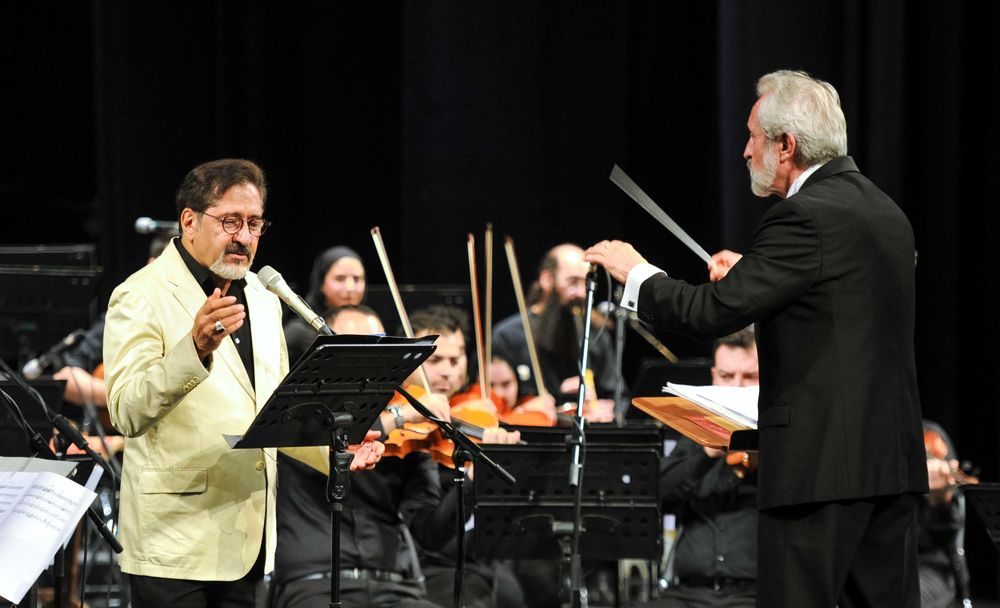
In two concerts held on May 31 and June 1, 2024 at Roudaki Hall, the Mitra Chamber String Orchestra — a privately supported ensemble of young musicians — presented an ambitious and diverse program under the baton of Mohammadreza Safavi, offering both moments of musical promise and clear signs of growing pains along their path to maturity.
Under the baton of Homayoun Rahimian, the National Orchestra of Iran delivered its second concert of 2024 titled “Mah-e Man” (My Moon) on July 2 and 3 at Tehran’s Vahdat Hall, featuring renowned vocalist Hessamoddin Seraj. Just three weeks earlier, on June 8 and 9, the orchestra had performed “Dar Rahgozarat” alongside Abdolhossein Mokhtabad.
The “Mah-e Man” program included celebrated pieces such as “Maleka Zekr-e To Guyam,” “Shab-e Asheghan-e Bidel,” “Mah-e Man,” “Shaaneh,” “Neshan-e Bi-Neshan,” and “Simin Bari,” all performed with Seraj’s iconic voice. In addition to the vocal works, the program featured three instrumental pieces: “Rhapsody for Violin and Orchestra” by Homayoun Rahimian, “Rangarang 1” by Rouhollah Khaleghi, and “Raghs-e Dayereh” composed by Heshmat Sanjari.
The concert opened with the nostalgic “Maleka Zekr-e To Guyam” (music by Farhad Rahimian, poetry by Sana’i), one of Seraj’s most recognized songs. However, early imbalances in vocal and orchestral dynamics emerged, with some words getting lost beneath the louder orchestration. Seraj’s singing lacked consistent attention to dynamic nuance and at times suffered from pitch inaccuracies, especially at the beginning of certain musical phrases.
The performance continued with “Shab-e Asheghan-e Bidel” (poetry by Saadi, composed by Rahimian) and the title track “Mah-e Man” (lyrics by Nezami Ganjavi, melody by Seraj, arranged by Amirhossein Ta’i). Compared to its previous outing, the National Orchestra showed improved rhythmic coordination, particularly in the execution of ritardandos and tighter synchronization among percussionists.
Still, occasional rhythmic inconsistencies remained, especially during passages requiring unified entrances across orchestral sections. These minor disruptions hinted at the need for more precise cues from the conductor and increased rehearsal focus on ensemble unity.
The instrumental section began with “Rhapsody for Violin and Orchestra,” featuring soloist Amir Nazari Salari, who delivered a compelling and expressive performance that showcased the Iranian violin’s emotional range. The orchestra played cleanly and effectively, confirming once again that it tends to shine more confidently in instrumental works with straightforward, faster rhythmic structures, as compared to slower, compound meters like the traditional 6/8.
“Rangarang 1” by Rouhollah Khaleghi followed, offering a charming, singable melody that easily resonated with the audience. Woodwinds and strings played a crucial role in shaping the primary theme. However, during a solo by the principal cellist, noticeable tuning issues slightly marred the otherwise smooth performance.
The third instrumental piece, “Raghs-e Dayereh” by Heshmat Sanjari, was rhythmically vibrant and well received by the audience. Though the orchestra could have handled the transitions in dynamics (from piano to forte and vice versa) more fluidly, the overall interpretation was compelling enough to prompt the audience to request the piece again as an encore.
In the final segment of the concert, Seraj returned to the stage to perform “Shaaneh” (an arrangement of an Arabic melody by Amirhossein Ta’i), “Neshan-e Bi-Neshan” (poetry by Hafez, music by Rahimian), “Simin Bari” (lyrics by Ebrahim Safayi, music by Jamshid Sheibani, arranged by Rahimian), and finally the patriotic anthem “Ey Iran.”
While Seraj’s distinct voice continues to hold a treasured place in the hearts of classical Persian music fans, his lack of synchronization with the orchestra — occasionally singing ahead of the ensemble — weakened the musical cohesion and emotional impact of several songs. Greater attentiveness to tempo and ensemble interplay could have elevated the concert further.
Nonetheless, Seraj’s decades of contribution to Iranian music deserve recognition and praise. In an era increasingly saturated by shallow pop trends, orchestral performances such as these are vital for nurturing and expanding the audience of authentic Iranian music. They remind us that traditional music not only endures but continues to evolve and inspire.
Written By Farid Parish
